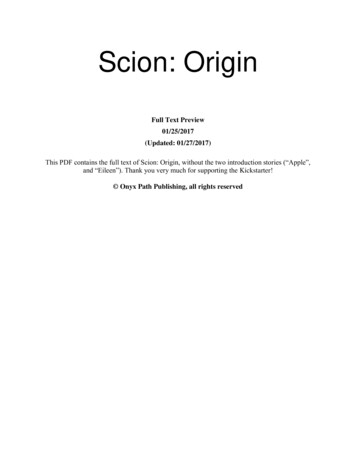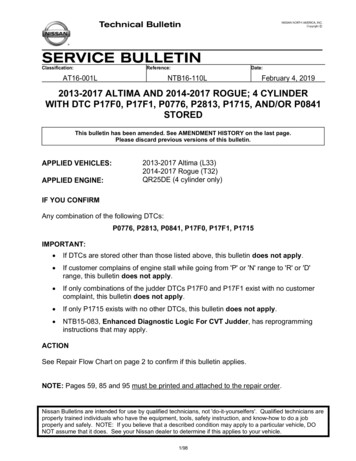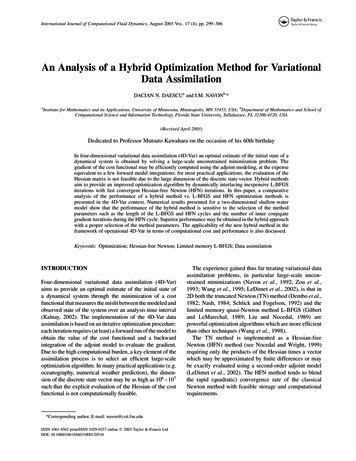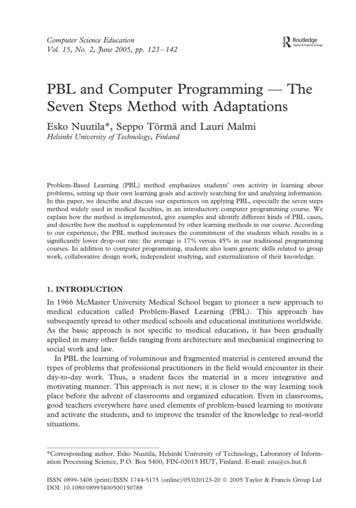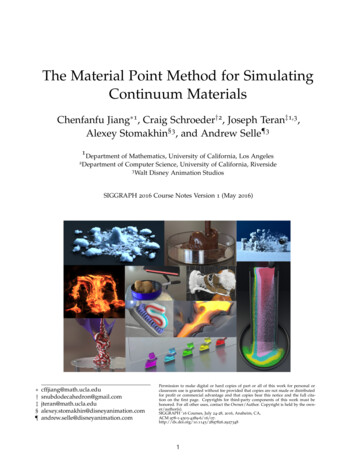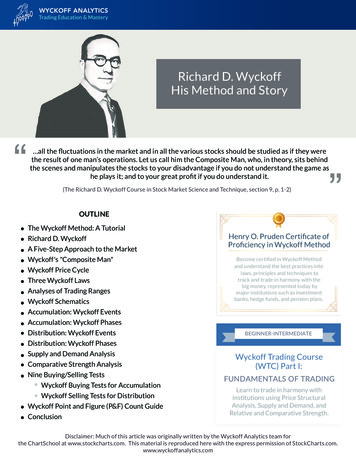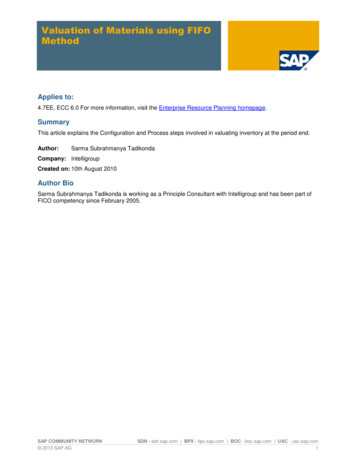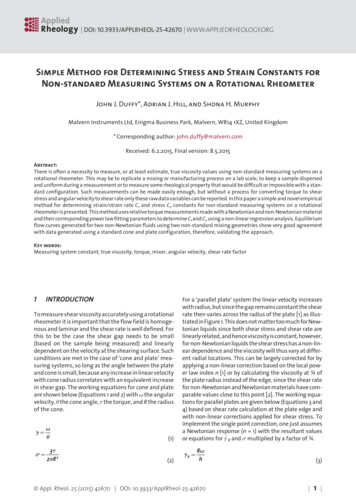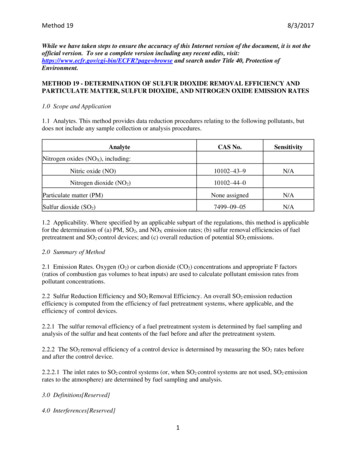
Transcription
Method 198/3/2017While we have taken steps to ensure the accuracy of this Internet version of the document, it is not theofficial version. To see a complete version including any recent edits, visit:https://www.ecfr.gov/cgi-bin/ECFR?page browse and search under Title 40, Protection ofEnvironment.METHOD 19 - DETERMINATION OF SULFUR DIOXIDE REMOVAL EFFICIENCY ANDPARTICULATE MATTER, SULFUR DIOXIDE, AND NITROGEN OXIDE EMISSION RATES1.0 Scope and Application1.1 Analytes. This method provides data reduction procedures relating to the following pollutants, butdoes not include any sample collection or analysis procedures.AnalyteCAS No.SensitivityNitric oxide (NO)10102–43–9N/ANitrogen dioxide (NO2)10102–44–0Nitrogen oxides (NOX), including:Particulate matter (PM)Sulfur dioxide (SO2)None assignedN/A7499–09–05N/A1.2 Applicability. Where specified by an applicable subpart of the regulations, this method is applicablefor the determination of (a) PM, SO2, and NOX emission rates; (b) sulfur removal efficiencies of fuelpretreatment and SO2 control devices; and (c) overall reduction of potential SO2 emissions.2.0 Summary of Method2.1 Emission Rates. Oxygen (O2) or carbon dioxide (CO2) concentrations and appropriate F factors(ratios of combustion gas volumes to heat inputs) are used to calculate pollutant emission rates frompollutant concentrations.2.2 Sulfur Reduction Efficiency and SO2 Removal Efficiency. An overall SO2 emission reductionefficiency is computed from the efficiency of fuel pretreatment systems, where applicable, and theefficiency of control devices.2.2.1 The sulfur removal efficiency of a fuel pretreatment system is determined by fuel sampling andanalysis of the sulfur and heat contents of the fuel before and after the pretreatment system.2.2.2 The SO2 removal efficiency of a control device is determined by measuring the SO2 rates beforeand after the control device.2.2.2.1 The inlet rates to SO2 control systems (or, when SO2 control systems are not used, SO2 emissionrates to the atmosphere) are determined by fuel sampling and analysis.3.0 Definitions[Reserved]4.0 Interferences[Reserved]1
Method 198/3/20175.0 Safety[Reserved]6.0 Equipment and Supplies[Reserved]7.0 Reagents and Standards[Reserved]8.0 Sample Collection, Preservation, Storage, and Transport[Reserved]9.0 Quality Control[Reserved]10.0 Calibration and Standardization[Reserved]11.0 Analytical Procedures[Reserved]12.0 Data Analysis and Calculations12.1 NomenclatureBwa Moisture fraction of ambient air, percent.Bws Moisture fraction of effluent gas, percent.%C Concentration of carbon from an ultimate analysis of fuel, weight percent.Cd Pollutant concentration, dry basis, ng/scm (lb/scf)%CO2d,%CO2w Concentration of carbon dioxide on a dry and wet basis, respectively, percent.Cw Pollutant concentration, wet basis, ng/scm (lb/scf).D Number of sampling periods during the performance test period.E Pollutant emission rate, ng/J (lb/million Btu).Ea Average pollutant rate for the specified performance test period, ng/J (lb/million Btu).Eao, Eai Average pollutant rate of the control device, outlet and inlet, respectively, for the performancetest period, ng/J (lb/million Btu).Ebi Pollutant rate from the steam generating unit, ng/J (lb/million Btu)Ebo Pollutant emission rate from the steam generating unit, ng/J (lb/million Btu).Eci Pollutant rate in combined effluent, ng/J (lb/million Btu).Eco Pollutant emission rate in combined effluent, ng/J (lb/million Btu).2
Method 198/3/2017Ed Average pollutant rate for each sampling period (e.g., 24-hr Method 6B sample or 24-hr fuel sample)or for each fuel lot (e.g., amount of fuel bunkered), ng/J (lb/million Btu).Edi Average inlet SO2 rate for each sampling period d, ng/J (lb/million Btu)Eg Pollutant rate from gas turbine, ng/J (lb/million Btu).Ega Daily geometric average pollutant rate, ng/J (lbs/million Btu) or ppm corrected to 7 percent O2.Ejo,Eji Matched pair hourly arithmetic average pollutant rate, outlet and inlet, respectively, ng/J(lb/million Btu) or ppm corrected to 7 percent O2.Eh Hourly average pollutant, ng/J (lb/million Btu).Ehj Hourly arithmetic average pollutant rate for hour “j,” ng/J (lb/million Btu) or ppm corrected to 7percent O2.EXP Natural logarithmic base (2.718) raised to the value enclosed by brackets.Fd, Fw, Fc Volumes of combustion components per unit of heat content, scm/J (scf/million Btu).GCV Gross calorific value of the fuel consistent with the ultimate analysis, kJ/kg (Btu/lb).GCVp, GCVr Gross calorific value for the product and raw fuel lots, respectively, dry basis, kJ/kg(Btu/lb).%H Concentration of hydrogen from an ultimate analysis of fuel, weight percent.H Total number of operating hours for which pollutant rates are determined in the performance testperiod.Hb Heat input rate to the steam generating unit from fuels fired in the steam generating unit, J/hr(million Btu/hr).Hg Heat input rate to gas turbine from all fuels fired in the gas turbine, J/hr (million Btu/hr).%H2O Concentration of water from an ultimate analysis of fuel, weight percent.Hr Total numbers of hours in the performance test period (e.g., 720 hours for 30-day performance testperiod).K Conversion factor, 10 5(kJ/J)/(%) [106 Btu/million Btu].Kc (9.57 scm/kg)/% [(1.53 scf/lb)/%].Kcc (2.0 scm/kg)/% [(0.321 scf/lb)/%].Khd (22.7 scm/kg)/% [(3.64 scf/lb)/%].3
Method 198/3/2017Khw (34.74 scm/kg)/% [(5.57 scf/lb)/%].Kn (0.86 scm/kg)/% [(0.14 scf/lb)/%].Ko (2.85 scm/kg)/% [(0.46 scf/lb)/%].Ks (3.54 scm/kg)/% [(0.57 scf/lb)/%].Kw (1.30 scm/kg)/% [(0.21 scf/lb)/%].ln Natural log of indicated value.Lp,L r Weight of the product and raw fuel lots, respectively, metric ton (ton).%N Concentration of nitrogen from an ultimate analysis of fuel, weight percent.N Number of fuel lots during the averaging period.n Number of fuels being burned in combination.nd Number of operating hours of the affected facility within the performance test period for each Eddetermined.nt Total number of hourly averages for which paired inlet and outlet pollutant rates are available withinthe 24-hr midnight to midnight daily period.%O Concentration of oxygen from an ultimate analysis of fuel, weight percent.%O2d, %O2w Concentration of oxygen on a dry and wet basis, respectively, percent.Ps Potential SO2 emissions, percent.%Rf SO2 removal efficiency from fuel pretreatment, percent.%Rg SO2 removal efficiency of the control device, percent.%Rga Daily geometric average percent reduction.%Ro Overall SO2 reduction, percent.%S Sulfur content of as-fired fuel lot, dry basis, weight percent.Se Standard deviation of the hourly average pollutant rates for each performance test period, ng/J(lb/million Btu).%Sf Concentration of sulfur from an ultimate analysis of fuel, weight percent.4
Method 198/3/2017Si Standard deviation of the hourly average inlet pollutant rates for each performance test period, ng/J(lb/million Btu).So Standard deviation of the hourly average emission rates for each performance test period, ng/J(lb/million Btu).%Sp, %Sr Sulfur content of the product and raw fuel lots respectively, dry basis, weight percent.T0.95 Values shown in Table 19–3 for the indicated number of data points n.Xk Fraction of total heat input from each type of fuel k.12.2 Emission Rates of PM, SO2, and NOX. Select from the following sections the applicable procedureto compute the PM, SO2, or NOX emission rate (E) in ng/J (lb/million Btu). The pollutant concentrationmust be in ng/scm (lb/scf) and the F factor must be in scm/J (scf/million Btu). If the pollutantconcentration (C) is not in the appropriate units, use Table 19–1 in Section 17.0 to make the properconversion. An F factor is the ratio of the gas volume of the products of combustion to the heat content ofthe fuel. The dry F factor (Fd) includes all components of combustion less water, the wet F factor (Fw)includes all components of combustion, and the carbon F factor (Fc) includes only carbon dioxide.Note: Since Fw factors include water resulting only from the combustion of hydrogen in the fuel, theprocedures using Fw factors are not applicable for computing E from steam generating units with wetscrubbers or with other processes that add water (e.g., steam injection).12.2.1 Oxygen-Based F Factor, Dry Basis. When measurements are on a dry basis for both O (%O2d) andpollutant (Cd) concentrations, use the following equation:12.2.2 Oxygen-Based F Factor, Wet Basis. When measurements are on a wet basis for both O2 (%O2w)and pollutant (Cw) concentrations, use either of the following:12.2.2.1 If the moisture fraction of ambient air (Bwa) is measured:Instead of actual measurement, Bwa may be estimated according to the procedure below.Note: The estimates are selected to ensure that negative errors will not be larger than 1.5 percent.However, positive errors, or over-estimation of emissions by as much as 5 percent may be introduceddepending upon the geographic location of the facility and the associated range of ambient moisture.12.2.2.1.1 Bwa 0.027. This value may be used at any location at all times.5
Method 198/3/201712.2.2.1.2 Bwa Highest monthly average of Bwa that occurred within the previous calendar year at thenearest Weather Service Station. This value shall be determined annually and may be used as an estimatefor the entire current calendar year.12.2.2.1.3 Bwa Highest daily average of Bwa that occurred within a calendar month at the nearestWeather Service Station, calculated from the data from the past 3 years. This value shall be computed foreach month and may be used as an estimate for the current respective calendar month.12.2.2.2 If the moisture fraction (Bws) of the effluent gas is measured:12.2.3 Oxygen-Based F Factor, Dry/Wet Basis.12.2.3.1 When the pollutant concentration is measured on a wet basis (Cw) and O2 concentration ismeasured on a dry basis (%O2d), use the following equation:12.2.3.2 When the pollutant concentration is measured on a dry basis (Cd) and the O2 concentration ismeasured on a wet basis (%O2w), use the following equation:12.2.4 Carbon Dioxide-Based F Factor, Dry Basis. When measurements are on a dry basis for both CO2(%CO2d) and pollutant (Cd) concentrations, use the following equation:12.2.5 Carbon Dioxide-Based F Factor, Wet Basis. When measurements are on a wet basis for both CO2(%CO2w) and pollutant (Cw) concentrations, use the following equation:12.2.6 Carbon Dioxide-Based F Factor, Dry/Wet Basis.12.2.6.1 When the pollutant concentration is measured on a wet basis (Cw) and CO2 concentration ismeasured on a dry basis (%CO2d), use the following equation:6
Method 198/3/201712.2.6.2 When the pollutant concentration is measured on a dry basis (Cd) and CO2 concentration ismeasured on a wet basis (%CO2w), use the following equation:12.2.7 Direct-Fired Reheat Fuel Burning. The effect of direct-fired reheat fuel burning (for the purpose ofraising the temperature of the exhaust effluent from wet scrubbers to above the moisture dew-point) onemission rates will be less than 1.0 percent and, therefore, may be ignored.12.2.8 Combined Cycle-Gas Turbine Systems. For gas turbine-steam generator combined cycle systems,determine the emissions from the steam generating unit or the percent reduction in potential SO2emissions as follows:12.2.8.1 Compute the emission rate from the steam generating unit using the following equation:12.2.8.1.1 Use the test methods and procedures section of 40 CFR Part 60, Subpart GG to obtain Eco andEg. Do not use Fw factors for determining Eg or Eco. If an SO2 control device is used, measure Eco after thecontrol device.12.2.8.1.2 Suitable methods shall be used to determine the heat input rates to the steam generating units(Hb) and the gas turbine (Hg).12.2.8.2 If a control device is used, compute the percent of potential SO2 emissions (Ps) using thefollowing equations:Note: Use the test methods and procedures section of Subpart GG to obtain Eci and Eg. Do not use Fwfactors for determining Eg or Eci.7
Method 198/3/201712.3 F Factors. Use an average F factor according to Section 12.3.1 or determine an applicable F factoraccording to Section 12.3.2. If combined fuels are fired, prorate the applicable F factors using theprocedure in Section 12.3.3.12.3.1 Average F Factors. Average F factors (Fd, Fw, or Fc) from Table 19–2 in Section 17.0 may be used.12.3.2 Determined F Factors. If the fuel burned is not listed in Table 19–2 or if the owner or operatorchooses to determine an F factor rather than use the values in Table 19–2, use the procedure below:12.3.2.1 Equations. Use the equations below, as appropriate, to compute the F factors:Note: Omit the %H2O term in the equations for Fw if %H and %O include the unavailable hydrogen andoxygen in the form of H2O.)12.3.2.2 Use applicable sampling procedures in Section 12.5.2.1 or 12.5.2.2 to obtain samples foranalyses.12.3.2.3 Use ASTM D 3176–74 or 89 (all cited ASTM standards are incorporated by reference—see§60.17) for ultimate analysis of the fuel.12.3.2.4 Use applicable methods in Section 12.5.2.1 or 12.5.2.2 to determine the heat content of solid orliquid fuels. For gaseous fuels, use ASTM D 1826–77 or 94 (incorporated by reference—see §60.17) todetermine the heat content.12.3.3 F Factors for Combination of Fuels. If combinations of fuels are burned, use the followingequations, as applicable unless otherwise specified in an applicable subpart:8
Method 198/3/201712.4 Determination of Average Pollutant Rates.12.4.1 Average Pollutant Rates from Hourly Values. When hourly average pollutant rates (Eh), inlet oroutlet, are obtained (e.g., CEMS values), compute the average pollutant rate (Ea) for the performance testperiod (e.g., 30 days) specified in the applicable regulation using the following equation:12.4.2 Average Pollutant Rates from Other than Hourly Averages. When pollutant rates are determinedfrom me
Heat input rate to the steam generating unit from fuels fired in the steam generating unit, J/hr (million Btu/hr). H g Heat input rate to gas turbine from all fuels fired in the gas turbine, J/hr (million Btu/hr). %H 2 O Concentration of water from an ultimate analysis of fuel, weight percent. H r Total numbers of hours in the performance test period (e.g., 720 hours for 30-day .

